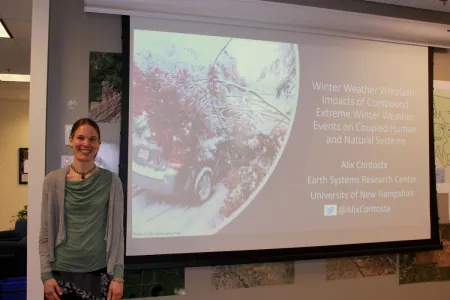
In the last few years, have you experienced a week that’s left you wearing a t-shirt, a parka, and galoshes in the span of just a few days? Think of an unusually warm, 70-degree weekend in January, immediately followed by a sudden drop of temperatures and a few inches of snow, only to be succeeded by a couple of days of rain. Does it all sound far-fetched or surprisingly familiar?
These kinds of unpredictable weather patterns are being called “winter weather whiplash,” perhaps due to the feeling they leave of being jerked sharply from one weather extreme to another. Scientists say these kinds of weather events may increase in frequency and intensity with climate change, but the potential social impacts of these weather events are harder to predict.
Dr. Alix Contosta, from the University of New Hampshire, is one scientist who’s seeking to better understand winter weather whiplash. In 2019, Contosta was a visiting scholar at SESYNC, and she recently led a research pursuit on winter weather whiplash with Dr. Nora Casson, from the University of Winnipeg. This past Tuesday, she returned to SESYNC for the Center’s weekly seminar series to present: ‘Winter Weather Whiplash: Impacts of Compound Extreme Winter Weather Events on Coupled Human and Natural Systems.’
During the seminar, Contosta explained how her team’s research has had three main objectives: 1) to define what constitutes winter weather whiplash; 2) to develop metrics for identifying those events; and 3) to determine the events’ impacts.
Critical to getting their research off the ground, however, was agreeing upon a common definition for the term “winter weather whiplash.” Contosta explained how finding a consensus across disciplines was a challenge because of the nuanced differences among various fields.
To illustrate her point, she asked the audience to consider how they would identify the start of winter. Responses varied from a certain animal entering hibernation, to a deep freeze, the winter solstice, or even the temperature dropping below a certain threshold. The exercise demonstrated the complexity of defining even a common word.
Ultimately, she said her team settled on this definition for winter weather whiplash: “A class of extreme events in which a collision of unexpected conditions produces a forceful, rapid, back-forth change in winter weather and induces an unexpected impact on natural and/or human systems.”
With this definition established, the team was then able to develop the first conceptual model of winter weather whiplash. Next, she explained that they turned to datasets available through New Hampshire’s Hubbard Brook Experimental Forest, which they used to translate their established definition of winter weather whiplash and conceptual framework into quantitative metrics that they could use to identify such events.
Having set metrics will enable the team to move into the next phase of their project, investigating the impacts of these extreme weather events on linked human and natural systems. This summer, Dr. Contosta will return to SESYNC as a visiting scholar to further her team’s work as they expand their study domain to include all of eastern North America and begin evaluating changes through both space and time.
More information about this Pursuit is available in the team’s first synthesis paper, published in Earth’s Future late last year.
